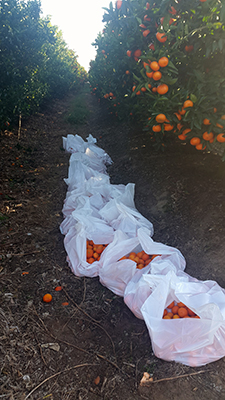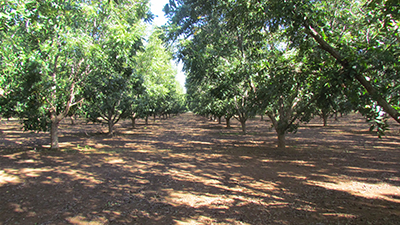Latest News Archive
Please select Category, Year, and then Month to display items
17 May 2024
|
Story Anthony Mthembu
|
Photo Supplied
 Prof Magdalena Sobon from Poland and Michael Jackson Blebo from Ghana shared their expertise with staff and students during their visit to the Department of Fine Arts at the University of the Free State.
Prof Magdalena Sobon from Poland and Michael Jackson Blebo from Ghana shared their expertise with staff and students during their visit to the Department of Fine Arts at the University of the Free State.
In a concerted effort to solidify its identity in South Africa and abroad, the Department of Fine Arts at the University of the Free State (UFS) recently played host to two distinguished artists: Prof Magdalena Sobon from the Wladyslaw Strzeminski Academy of Fine Arts in Lodz, and the Ghanaian multidisciplinary artist, Michael Jackson Blebo.
Dr Adelheid Von Maltitz, Senior Lecturer in the Department of Fine Arts at UFS, lauded the visits, held between 19 and 29 March 2024, as an enriching learning experience for the faculty and students within the department.
The visit highlights
During their visit to UFS, Prof Sobon and Blebo actively engaged with the department’s staff and students. Prof Sobon, an acknowledged paper-making artist, conducted a comprehensive two-day workshop, imparting extensive knowledge in this craft. As a direct outcome of this workshop, the department has procured the requisite equipment and materials, enriching the students’ capabilities in this medium. Blebo on the other hand, conducted a demonstration on clay bust modelling and both artists participated in critique sessions with the fourth-year students. Dr Von Maltitz underlined the significance of Blebo’s African heritage, noting, ‘’For our students to interact with a young, accomplished artist of his calibre is of benefit to them in terms of how they may envision their art careers.’’ Of particular note were Prof Sobon’s interactions with the students, wherein she shared her own artistic practices from her student years during her lectures.
In addition to their engagements with the students, Prof Sobon and Blebo also had the opportunity to present their research to second-year sculpture students at the Richmond Land Art Project, an off-campus initiative fostering art creation centred on socio-economic and other pertinent issues.
Future collaborations
Dr Von Maltitz emphasised the importance of maintaining ties with these eminent artists for the department’s growth and global outreach. Prof Sobon’s visit has paved the way for two department members to visit the Wladyslaw Strzeminski Academy of Fine Arts in Lodz in the near future. ‘’These individuals will get an opportunity to learn about studio setups and network with fellow academics, creative researchers, and artists,’’ stated Dr Von Maltitz. She hailed the visit by the two artists as both stimulating and fruitful, particularly for the students.
Plant eco-physiologist finds effective solutions for crop optimisation
2016-07-24

The bio-stimulant was tested on
this citrus. This is the first time
that the product has been tested
on a crop.
In a time characterised by society facing increasing population growth, food crises, and extreme climatic conditions such as drought, it is essential for farmers to integrate science with their work practices in order to optimise crops.
Role of photosynthesis and plant sap data
By knowing how to use photosynthesis and plant sap data for determining plant health, fast and effective solutions could be established for the optimisation of crops. This technique, which could help farmers utilise every bit of usable land effectively, is the focus of Marguerite Westcott’s PhD study. She is a junior lecturer and plant eco-physiologist in die Department of Plant Sciences at the University of the Free State.
Westcott uses this technique in her studies to prove that a newly-developed bio-stimulant stimulates plants in order to metabolise water and other nutrients better, yielding increased crops as a result.
Agricultural and mining sectors benefit from research
The greatest part of these projects focuses on the agricultural sector. Westcott and a colleague, Dr Gert Marais, are researching the physiology of pecan and citrus trees in order to optimise the growth of these crops, thus minimising disease through biological methods. Field trials are being conducted in actively-producing orchards in the Hartswater and Patensie areas in conjunction with the South African Pecan Nut Producers Association (SAPPA) amongst others.
The principles that Westcott applies in her research are also used in combination with the bio-stimulant in other studies on disturbed soil, such as mine-dump material, for establishing plants in areas where they would not grow normally. This is an economical way for both the agricultural and mining sectors to improve nutrient absorption, stimulate growth, and contribute to the sustainable utilisation of the soil.

The bio-stimulant contributes to the immunity of the plants.
It was tested in these pecan nut orchards (Hartswater).
Soil rehabilitation key aspect in research projects
“One of two things is happening in my research projects. Either the soil is rehabilitated to bring about the optimal growth of a plant, or the plants are used to rehabilitate the soil,” says Westcott.
Data surveys for her PhD studies began in 2015. “This will be a long-term project in which seasonal data will be collected continuously. The first set of complete field data, together with pot trial data, will be completed after the current crop harvest,” says Westcott.